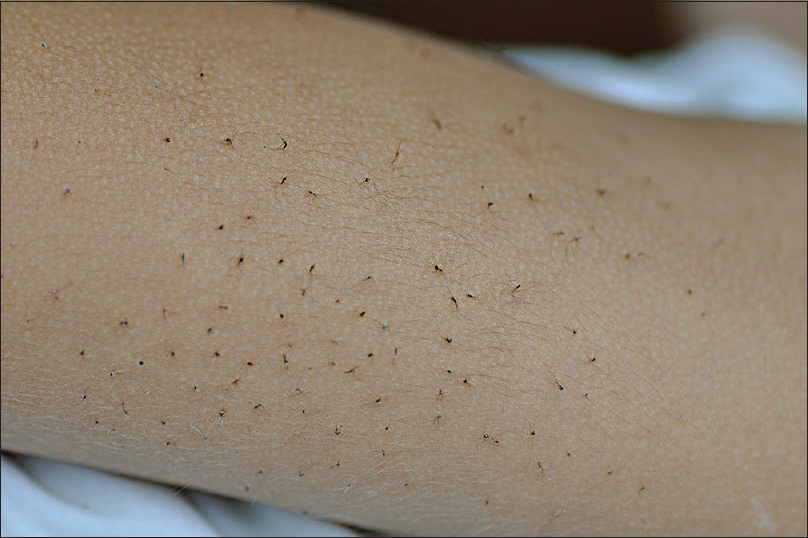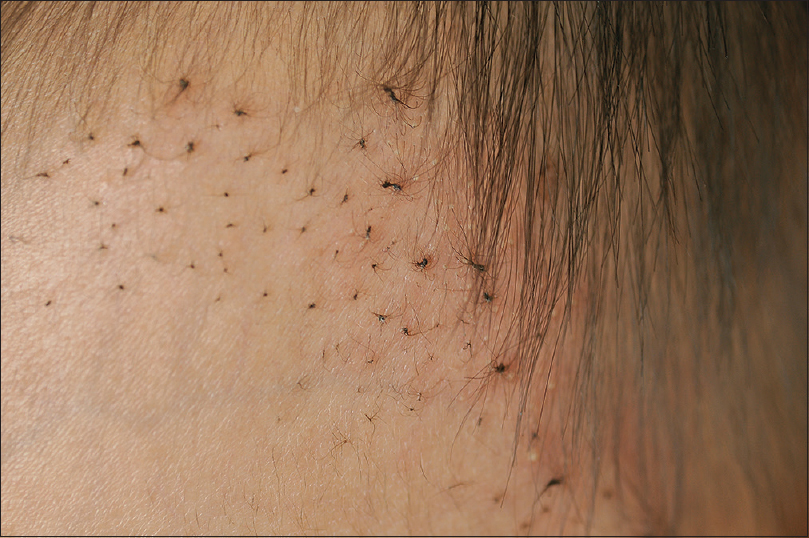Translate this page into:
Reversible twisted and rolled hairs due to manual twisting: Two case reports
2 Department of Dermatology, Maulana Azad Medical College and LNJP Hospital, New Delhi, India
Correspondence Address:
Di-Qing Luo
Department of Dermatology, The Eastern Hospital of The First Affiliated Hospital, Sun Yat-sen University, 183 Huangpu Rd. E., Guangzhou 510700
China
| How to cite this article: Luo DQ, Liu JH, Sarkar R, Zhao YK, Wang F, Wu HH. Reversible twisted and rolled hairs due to manual twisting: Two case reports. Indian J Dermatol Venereol Leprol 2018;84:763 |
Sir,
Almost everyone, especially people with longer hair, have experienced minor reversible tangling of scalp hair.[1] Because Asian hair is harder, straighter, and thinner and has greater diameter with circular geometry than that of Africans or Caucasians, as well as shorter and lesser body hair than that of other races, matted hair disorders are reported infrequently in Asians.[2],[3] Herein, we present two cases of twisted and rolled hair with multiple knots which occurred on the scalp and body hair, respectively.
Case 1: A 3.5-year-old Han Chinese boy was referred with a week history of “dark spotty rash” on both upper arms and upper back. A week prior to the presentation, the boy had anorexia and his grandmother twisted and rolled his hair on the back and arms with saliva-moistened fingers (a traditional local habit to treat anorexia) leading to the formation of body hair knots. His past medical history was unremarkable, however, his brother-in-law had presented similar condition when performing the above mentioned activity. Cutaneous examination showed multiple discrete black knots of hairs on both extensor aspects of upper arms and upper back that originated from multiple hair follicles [Figure - 1], with healthy underlying skin. The remaining body hair was normal; however, on twisting and rolling the hair nearby, a black knot could be easily formed. The morphology of the body hair was normal on macroscopic and microscopic examination, except that they seemed to be longer and denser than other children, although we could not confirm this finding. No pediculosis or nits were detected. The knots disappeared spontaneously in about 3 weeks after stopping the mechanical movement of twisting and rubbing. No recurrence occurred during 12-month follow up.
 |
| Figure 1: Multiple discrete black knots distributed over the left upper arm, which are originated from different hair follicles nearby |
Case 2: A 2.5-year-old healthy Han Chinese boy was incidentally found with asymptomatic, dark scattered knots of scalp hair when he was referred because of eczema. Examination showed multiple discrete hair knots on both sides of his forehead and the margins of scalp, originating from different follicles nearby [Figure - 2]. There was erythema around some knots. The scalp hair were soft in texture. The knots were reported to be formed by twisting and rolling the hair with saliva-moistened fingers by his grandmother because of his anorexia. No remaining parts were involved. His family history was unremarkable. However, some children in his village had reported of similar condition after rolling and rubbing the hair, when they had anorexia or fever. The knots loosened and disappeared gradually in 1 month without any treatment.
 |
| Figure 2: Multiple discrete black knots originating from different hair follicles at the margin of the scalp |
In 1994, Itin et al. reported 3 cases, including 1 Turkish girl and 2 white men from Switzerland, showing multiple discrete black knots of body hairs originating from different follicles, and termed it as “twisted and rolled body hair.”[4] A total of four additional cases were reported who were the relatives of the index case.[4] In 2015, Kim et al. reported the first case in Asians.[3] We have found that only 11 cases,[3],[4],[5] including the 4 additions in Itin's article[4] and our present cases, had been reported up to date; 2 (18.2%) were females and 9 (81.8%) males; with 7 (63.6%) Swiss, 1 (9.1%) Italian, 1 (9.1%) Korean, and 2 (18.2%) Chinese individuals. The age ranged from 4 weeks to 71 years (medium age: 26 years). The lesions were located on the back alone [8 (72.7%)], arms and legs [1 (9.1%)],[3],[4],[5] arms and back [1 (9.1%)], and left forehead and margins of scalp [1 (9.1%)]. All the prior cases [9 (81.8%)] involved body hair alone.[3],[4],[5] Based on the present cases, we considered that the term “twisted and rolled hairs” might be better than the previous term used to describe the disorder. Our experience also suggested that the disorder, as Resnik considered, is indeed not an infrequent one but only rarely reported.
The pathogenesis of “twisted and rolled hairs” is poorly understood, although both acquired defects and autosomal trait are considered to be responsible.[3],[4],[5] The present cases confirmed that it can be an acquired defect. The possible triggering factors for the present cases may include the soft hair and factitious twisting and rolling activity. Spontaneous remission after stopping manual force suggested that factitious rubbing is the most important factor. The erythema in the second case was probably secondary to the friction.
The differential diagnoses include trichonodosis, plica neuropathica, rolled hair, circle hair, and pili multigemini. Based on the clinical manifestations, the diagnosis is not difficult.
Although spontaneous remission might occur, no satisfactory treatment exists at present. For patients where it is caused by manual force, stopping factitious activity and “wait-and-see” approach may be the best. “Shaving off” is another option.
The main limitations of the present work are that we did not analyze the protein elements and did not compare the diameter and shape of the hair with others.
Acknowledgments
The authors sincerely thank the patients who participated in the present study and their guardians who signed the informed consents.
Financial support and sponsorship
Nil.
Conflicts of interest
There are no conflicts of interest.
| 1. |
Sarkar R, Kaur S, Thami GP, Kanwar AJ. “Plica neuropathica”: Matting of hair. Dermatology 2000;201:184-5.
[Google Scholar]
|
| 2. |
Luo DQ, Zhao YK, Liu JH. Cutaneous pili migrans. Ann Dermatol Venereol 2010;137:468-71.
[Google Scholar]
|
| 3. |
Kim SY, Yun SJ, Lee SC, Lee JB. Twisted and rolled body hairs: A new report in Asians. Ann Dermatol 2015;27:216-8.
[Google Scholar]
|
| 4. |
Itin PH, Bircher AJ, Lautenschlager S, Zuberbühler E, Guggenheim R. A new clinical disorder of twisted and rolled body hairs with multiple, large knots. J Am Acad Dermatol 1994;30:31-5.
[Google Scholar]
|
| 5. |
Barbareschi M, Sibillo E, Greppi F, Bruscagin C, Crosti C. “Twisted and rolled body hairs”: An ultrastructural study by means of scanning electron microscopy. Acta Derm Venereol 1997;77:409-10.
[Google Scholar]
|
Fulltext Views
3,763
PDF downloads
1,942





